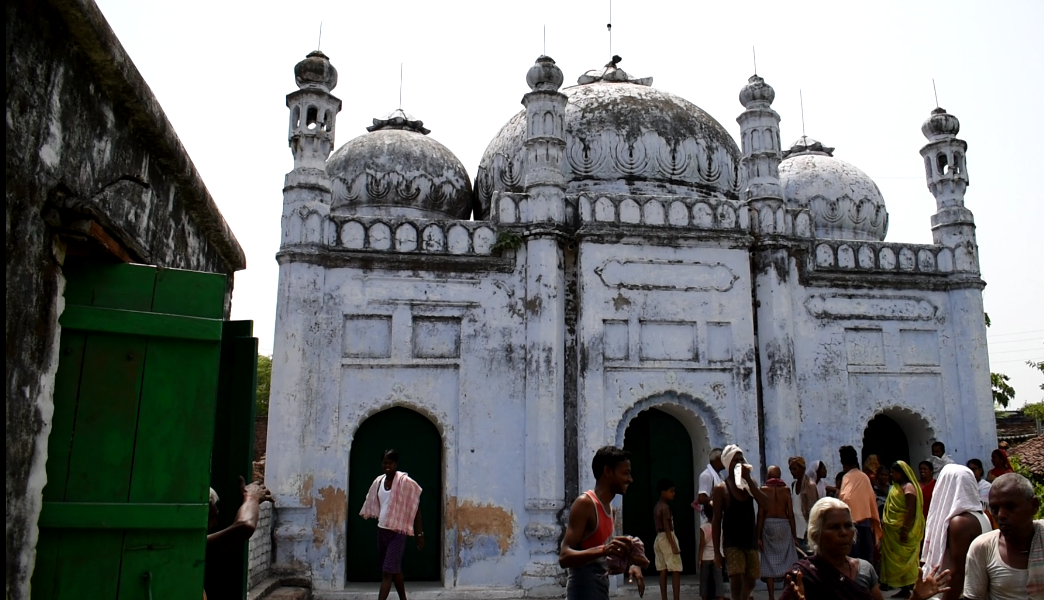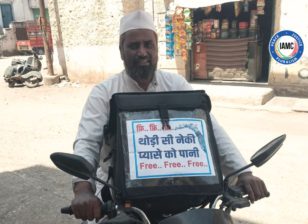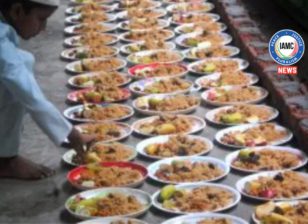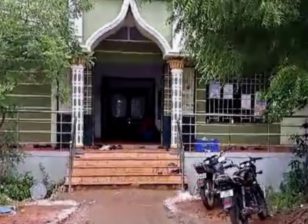Nalanda: By Keeping an Unused Mosque Running, Hindus of Mari Offer a Lesson in Humanity
Nalanda (Bihar): ‘Allahu Akbar, Allahu Akbar’ – as the azaan is relayed from the mosque over a loudspeaker, the stirring voice calling the faithful to prayer touches the heart.
It is time for the noon namaz – zuhr – except that this mosque in Mari village, in Bihar’s Nalanda district, has neither an imam nor a muezzin who calls the faithful to prayer five times a day. There is no expectation of anyone coming to the mosque to pray either. Reason being that there are no Muslims living in the village any more.
What remains is the memory of namaz being performed at the mosque regularly at some point in time – a memory that is etched on the hearts and minds of the residents of Mari, who happen to be Hindus.
It is they who have kept alive the daily practice of the azaan by using a recorded version.
The mosque in Mari village, said to be almost 200 years old, is bereft of the presence of Muslims and ‘desolate’ in some ways. Yet, it is marked by an undeniable air of liveliness, for the group of Hindu women, children, elders and youth who have gathered inside the mosque in spite of the sweltering heat have the same spirit of reverence with which the faithful enter any religious place.
In these times of religious frenzy and a polarising politics of hatred, when we are swamped by an unending cycle of news about shrines being vandalised, saffron flags being planted in Muslim religious places, and mosques being brought into contestation, the reverence that the Hindus of Mari village show for the mosque and the shrine in its premises comes as a benediction. One cannot help but see them as exemplars of communal harmony and fraternity.
While some might view this daily practice as a sign of the villagers’ old-fashioned worldview, others might see in it a glimpse of Sufi and Bhakti traditions.
Longstanding bond with the mosque
The mosque’s whitewashed walls speak of the significance it holds for the Hindu villagers. Above the space designated for the imam’s offering of namaz hangs a new framed image containing verses from the Quran (aayat). Among them is one that says: “For you, your faith; for me, mine.”
There is a sense of the sacred here that goes beyond the bounds of any organised religion.
On the pulpit, from where the imam must have delivered his sermon in the past, one can see several books – the Quran in Hindi and a copy of the book Sachchi Namaz. The Hindus of Mari have taken pains to ensure that these texts are in good condition.

The books kept in the mosque. Photo: Faiyaz Ahmad Wajeeh
The village, which falls in Ben Block and comes under the Kanth panchayat, is 14-15 km from Nalanda city. However, reaching it is not all that easy even with one’s own means of transport. Taking the narrow, winding, decrepit road – kutcha in places – sitting atop the embankment across the Paimar river one reaches Mari somehow.
The village has mostly pucca houses. But some of the residents who walk along on the main path to the mosque point out that illiteracy is a big problem, and there is nothing much by way of economic opportunities beyond farming.
Karu Tanti, who heads the panchayat as its mukhiya, has consented to be our guide. He says there are no Muslims in Mari village and the villages that fall under his panchayat: “Soon after the zamindari system was abolished, after independence, the Muslims of Mari and the villages around started migrating.”
For years now, says Tanti, the Hindus of Mari have ensured that the daily practice of the azaan continues to resonate across the village. The way he sees it, the villagers’ bond with the mosque goes back such a long way that it is now part of their collective memory and heritage, something they hold in trust for the ones who left.
At one time Muslims comprised half the village. Now Mari has only Hindus, mainly Kurmis and Paswans, as well as other castes.
Ram Naresh, a resident, gives an example of how the mosque is woven into their village tradition – no marriage is complete without the bridegroom’s procession first stopping at the mosque for blessings. He says when the mosque fell into disuse after the Muslims left the village, the Hindus started taking care of it, cleaning the entire premises daily and lighting a lamp.
Naresh describes the mosque as the soul of the village. He feels a sense of pride that he, like the generations before him, is able to contribute to the upkeep of the mosque. He says, “The mosque has no name. We call it dargah as the shrine of Baba Hazrat is located in the mosque premises.”
In the course of our conversation, we find ourselves at the mosque’s main doorway. Near it is a small niche in the wall, which contains a square stone. The villagers, who have given it the name ‘zar meher’, ascribe healing properties to it – a mere touch is sufficient. It is as if one has stepped into the pages of a folk tale. “It’s nothing but our faith. We feel at peace,” says Naresh. As for the origin of the stone, no one seems to know much.
Assuming a mysterious air Rajmanti Devi, an elderly resident of the village, refers to a Sufi saint’s presence in times unknown, which acts like a talisman for the villagers, keeping them safe from disasters of all kinds.
Geetu Devi adds, “On every significant occasion we come here [the mosque] first. Then we visit the temple of Mata Rani and other places.” She believes that the Hindus are merely observing their dharma. “If we don’t do so, something terrible will befall us.”

Rajmanti Devi and Geetu Devi. Photo: Faiyaz Ahmad Wajeeh
In response to a question, she makes a forceful point: “Jati-biradari [caste] is irrelevant. It is important for everyone to be able to live together. Whether a particular place of worship is a mosque or a temple is immaterial. We perform sewa at the temple of Mata Rani and we do the same at the mosque as well.”
She volunteers some more information. While it is Hindus who take care of the mosque, ‘‘Bhuttu miyan’ visits the dargah with his family every now and then. She is referring to Khalid Alam, or Bhuttu miyan as he is popularly known, who lives in Bihar Sharif (the administrative headquarters of Nalanda district) but traces his roots to Mari village. He is from the last generation of Muslims to leave the village more than three decades ago. His house, which he continues to own, is located next to the mosque.
A conversation with Alam reveals the deep bond he feels with Mari village. This, and the conversation with the villagers, indicates that even today the relationship between the two communities is of brotherhood. In many instances, the Hindus of the village look after the property owned by Muslims.
Mukhiya Tanti puts it succinctly: “There are no Muslims in the village today, but we have always had a cordial relationship with them. We also take part in each other’s festive occasions.”
Hindu or Muslim, the blood is one
There is a group of elderly women in the mosque that speaks in a slightly different tone. While they wholeheartedly affirm their harmonious relationship with the Muslims who trace their roots to the village, they have doubts on another score. They say that while Hindus continue to be good, one cannot say the same for Muslims elsewhere.
Perhaps they are referring to that wide swathe of unseen Muslims who have been demonised by the ruling dispensation and a large section of the mainstream media.
Meanwhile, the elderly Anil Paswan is eager to bring the discussion back to their village. Talking about the couple of months he slept in the mosque premises, he says he experienced an other-worldly power issuing the following command – continue with your good deeds and we shall do good by you.

The gumbad and minar of the mosque visible from outside. Photo: Faiyaz Ahmad Wajeeh
What he is saying is contrary to rationality, but the conviction that animates his belief is such that it makes one want to believe as well.
Yet another strand in the narrative is introduced by young Avnish Kumar who says that the faith of Hindus in the mosque goes back 200 years. “At present, Ajay Paswan, Gautam Mahato and Bakhori Jamadar ji have undertaken the task of the mosque’s upkeep and performance of sewa.” He adds that the villagers bear the expense of upkeep. Echoing the others he says, “It is now part of our tradition.”
It is fascinating to see how myths have become part of the narrative that has been built around the mosque, revealing its centrality in the psyche of the Hindus of Mari. For instance, they talk about how the healing stone, kept in the niche near the mosque’s main doorway, was once stolen. The way they see it, the thief must surely have experienced some ill-luck which made him return the stone.
Just then Ajay Paswan, a raj mistri, joins us in the mosque. He has brought his two children with him. In the manner of a true-bred Muslim he makes a precise gesture of salaam, saying, “We are just continuing with the tradition of sewa that our ancestors did. We will perform sewa here as long as we are alive.”
Mentioning their daily practice of the azaan, accessed through versions stored on a pen drive, he says, “We clean the premises regularly, burn incense, offer chadar at the shrine. We are blessed. What more can one say?”
In response to a question Paswan emphasises that no one in the village has any problems with the azaan. Wherever such things happen, it is due to politics and political jockeying. All this is done to grab power. If you ask me, there are only two jatis – man and woman. Hindu or Muslim, the blood coursing through their veins is one.
The raj mistri keeps himself abreast of current affairs. Mentioning the recent incident of the former BJP spokesperson Nupur Sharma’s comments about the Prophet Mohammad, he says, “The three of us who are responsible for the upkeep of the mosque have nothing to do with politicians. The ruling dispensation always has a hand in these things which strain the relationship between Hindus and Muslims. “
Proudly referring to his village Paswan says, “Look at our village. We are all of one mind, we tend the shrine. We have made arrangements for the azaan, and have faith in it.”
Communalism was not the reason for migration
According to some localised news reports, the migration of Muslims from Mari in 1942, 1946 and 1981 was triggered by communal violence. Mukhiya Tanti refutes any such suggestion, saying that the Muslims left the village over a period of time in search of a better life.
Naresh, who was born around 1960, says that he has childhood memories of namaz being performed in the mosque. Paswan draws attention to the continuing lack of business opportunities in what is essentially a rural area, citing it as the main reason for the migration of Muslims to Bihar Sharif, Delhi and Kolkata: “It is not that they were forced to leave because of communal riots. Some Muslims still own land here. It is cultivated by the villagers on a sharecropping basis.”
The fact that Muslims comprised half the village at one time and have no presence at all now in Mari, might make people wonder about it, says Paswan. “But it was not like they were hounded out. They left as per their convenience. Everything else is politics and one should not get trapped in its coils.”

A view of the mosque from the main street in Mari. Photo: Faiyaz Ahmad Wajeeh
When asked about it, Alam gives his take on the issue, namely that in 1942, 1946 and 1981, there were times when Hindus and Muslims were face-to-face in the village, with the tension building up for a confrontation, but no one faced huge losses.
He mentions that in an early instance of tension in the village, only 10-15 Muslims were involved. On another occasion, when it seemed that things might go out of hand, Congress leader Mudrika Singh pitched camp in the village. Those incidents were not like the large-scale communal outbursts that are seen in our times, he adds.
Alam’s view is that because there was no large-scale loss of property or life in these instances of build-up of tension or clashes, even the Hindu villagers do not perceive them as communal riots. Like the Hindus of Mari, he too is of the view that the post-1947 abolition of the zamindari system was the main trigger for several waves of migration of Muslims. Following the tension of 1981, the few remaining families also left the village.
He shares some interesting facts about the mosque, saying it was constructed almost 200 years ago by his ancestor Kabir Alam, who was a zamindar. Before that the nearest mosque where the Muslims of Mari could offer namaz was some distance away, in Bargaon. Often, they would not reach in time for namaz. The construction of a mosque in Mari solved that problem.
Every village has a past
Talking about the history of the village, Alam says it was the mandi of Nalanda at one time. Gradually, people started calling the village Mari, a distortion of mandi.
“It is said that the village suffered the grievous impact of at least four floods and the ravages of fire in the past. Its name also kept changing – from Neem Mari, Musharkat Mari and Paav Mari to the present-day official name of Ismailpur Mari.” Like most official names, it is confined to the record.
Alam says Ismailpur Mari owes its name to the presence of Hazrat Ismail who rests in the grave in the mosque premises. Legend has it that the village stopped experiencing the scourge of floods and fire once he came to the village. Due to the saint’s blessing Mari village got a new lease of life. The villagers call him by various names – Hazrat Ismail, Baba Hazrat and Makhdoom Sahab.
While not totally discounting the clashes as an additional reason for the migration of Muslims from the village, Alam emphasises its backwardness as the main push factor. Moreover, the Paimar river always posed a threat of flood (the dam came later). The narrow decrepit road, which has made travel to and from the village a little easier, came up only recently, during the tenure of time of the Nitish Kumar government.
Mari is not far from Nalanda, Bihar Sharif and Rajgir, places that have been witness to Gautam Buddha’s teachings, the aura of Sufi shrines, the reverence accorded to sacred water tanks in Hindu and Muslim religious places. These are sites that are testimony to history’s civilisational march.
The village, too, has forged a unique tradition by creating its own universe of belief when it comes to the mosque and shrine. More importantly, the younger generation of Hindus is determined to keep this tradition alive. Their desire to keep alive the belief of another religion and their resolve to continue a daily practice like the azaan, which is so integral to a religion other than theirs, presents an extraordinary example of harmony and fraternity in our troubled times. They have shown that if there is a message to be given to the world it is one of love.
Translated from the Hindi original by Chitra Padmanabhan.
This article orginally appeared in The Wire




